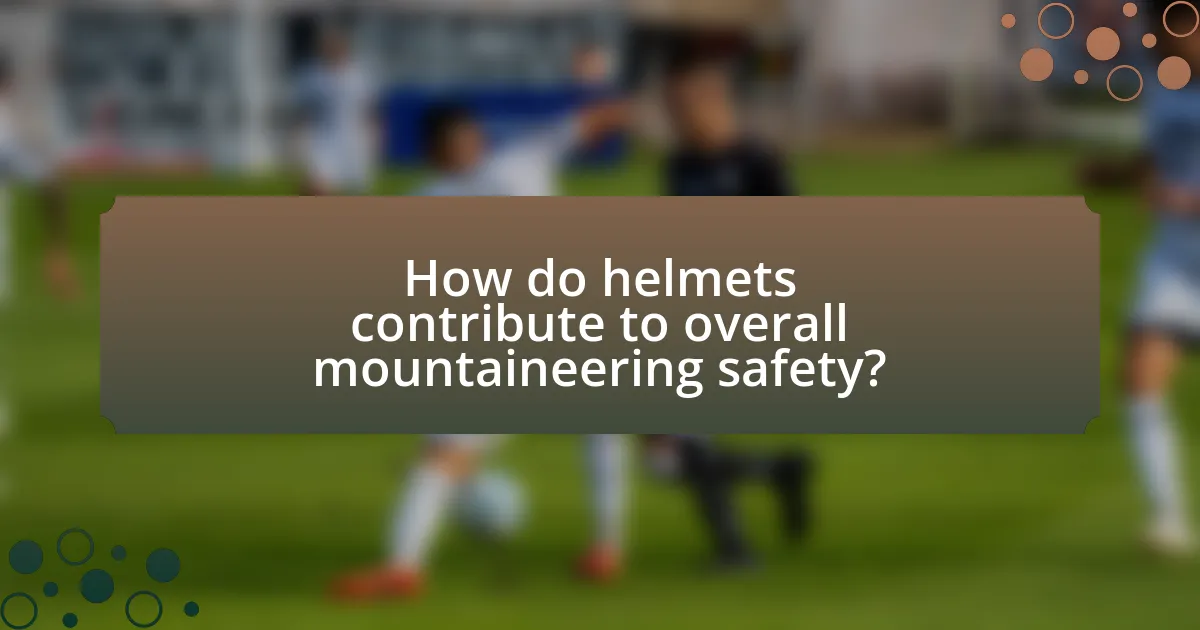The article focuses on the critical role of helmets in mountaineering, emphasizing their importance in preventing head injuries from falls, rockfalls, and impacts. It highlights that head injuries account for a significant percentage of climbing-related accidents, with studies showing that wearing a helmet can reduce the risk of severe head trauma by up to 85%. The article details the types of helmets available, their key features, materials used in construction, and best practices for fitting, maintenance, and usage. Additionally, it discusses the importance of helmets in overall safety and risk management for climbers, supported by relevant statistics and safety standards.

What is the Importance of Helmets in Mountaineering?
Helmets are crucial in mountaineering as they provide essential protection against head injuries from falling rocks, ice, and impacts during falls. The risk of head trauma in mountaineering is significant, with studies indicating that head injuries account for a substantial percentage of climbing-related accidents. For instance, a study published in the Journal of Sports Medicine found that head injuries represented approximately 20% of all climbing injuries. Wearing a helmet can significantly reduce the severity of these injuries, as modern helmets are designed to absorb impact and distribute force effectively.
Why are helmets essential for mountaineers?
Helmets are essential for mountaineers because they provide critical protection against head injuries from falling rocks, ice, and impacts during falls. In mountainous environments, the risk of rockfall is significant; studies indicate that up to 30% of climbing accidents involve head injuries, underscoring the necessity of wearing a helmet. Additionally, helmets are designed to absorb impact energy, reducing the severity of injuries in case of accidents. The use of helmets has been shown to decrease the likelihood of severe head trauma, making them a vital piece of safety equipment for anyone engaging in mountaineering activities.
What types of head injuries can helmets prevent?
Helmets can prevent various types of head injuries, including concussions, skull fractures, and lacerations. Concussions occur when the brain is jolted inside the skull, often due to impact, and helmets are designed to absorb and distribute that force, reducing the risk. Skull fractures can result from direct blows to the head, and helmets provide a protective barrier that can significantly decrease the likelihood of such injuries. Additionally, helmets can prevent lacerations to the scalp and face by covering these vulnerable areas during falls or collisions. Studies have shown that wearing helmets reduces the incidence of head injuries in activities like mountaineering, highlighting their critical role in safety.
How do helmets enhance safety during climbs?
Helmets enhance safety during climbs by providing crucial protection against head injuries from falls, rockfalls, and impacts. They are designed with materials that absorb shock and distribute the force of an impact, significantly reducing the risk of traumatic brain injuries. Studies indicate that wearing a helmet can decrease the likelihood of head injuries by up to 85% in climbing accidents, highlighting their effectiveness in safeguarding climbers.
What are the key features of mountaineering helmets?
Mountaineering helmets are designed with several key features that enhance safety and performance. These features include impact resistance, which is typically achieved through materials like polycarbonate or fiberglass that absorb shock from falls or falling debris. Additionally, mountaineering helmets often have a lightweight construction to ensure comfort during long climbs, while ventilation systems are incorporated to improve airflow and reduce heat buildup. Furthermore, adjustable straps and a secure fit are essential for stability, preventing the helmet from shifting during movement. Many helmets also come equipped with attachment points for headlamps or other gear, adding functionality for climbers. These features collectively ensure that mountaineering helmets provide optimal protection and usability in challenging environments.
What materials are commonly used in helmet construction?
Common materials used in helmet construction include polycarbonate, fiberglass, and expanded polystyrene (EPS). Polycarbonate is a lightweight and impact-resistant plastic that provides durability, while fiberglass offers strength and rigidity. EPS is commonly used for the inner foam layer, which absorbs shock during impacts. These materials are selected for their ability to protect the head from injuries, as evidenced by safety standards that helmets must meet, such as those set by the American National Standards Institute (ANSI) and the European Committee for Standardization (CEN).
How does the design of a helmet affect its performance?
The design of a helmet significantly affects its performance by influencing impact resistance, comfort, and ventilation. Helmets with advanced materials, such as polycarbonate or carbon fiber, provide superior impact absorption, reducing the risk of head injuries during falls. Additionally, ergonomic designs enhance fit and comfort, allowing for prolonged wear without discomfort, which is crucial in mountaineering where extended use is common. Effective ventilation systems in helmet designs help regulate temperature, preventing overheating during strenuous activities. Research indicates that helmets designed with these features can reduce the likelihood of concussions by up to 85%, demonstrating the critical role of design in helmet efficacy.
What are the different types of helmets available for mountaineering?
The different types of helmets available for mountaineering include hard-shell helmets, foam helmets, and hybrid helmets. Hard-shell helmets provide maximum protection with a durable outer shell, making them suitable for rocky environments. Foam helmets are lightweight and offer comfort, ideal for less technical climbs. Hybrid helmets combine features of both hard-shell and foam designs, providing a balance of protection and weight. Each type is designed to meet specific safety standards, such as those set by the American National Standards Institute (ANSI) and the European Committee for Standardization (CE), ensuring reliability in various mountaineering conditions.
What distinguishes climbing helmets from other types?
Climbing helmets are distinguished from other types of helmets by their specific design features aimed at protecting against falling objects and impacts during climbing activities. Unlike standard helmets, climbing helmets are typically lightweight, have ventilation systems for breathability, and are constructed with materials that absorb shock effectively, such as expanded polystyrene foam or polycarbonate shells. These features are essential for climbers, as they face unique hazards such as rockfall and the potential for falls from heights. Additionally, climbing helmets often include a secure fit system and compatibility with headlamps, enhancing their functionality in outdoor environments.
How do full-shell and half-shell helmets compare?
Full-shell helmets provide more comprehensive protection than half-shell helmets, covering the entire head and offering better impact resistance. Full-shell designs typically feature a solid outer shell and additional padding, which enhances safety during falls or collisions, as evidenced by studies showing a significant reduction in head injuries among users. In contrast, half-shell helmets offer limited coverage, primarily protecting the top of the head, which may leave the sides and back vulnerable. Research indicates that full-shell helmets are preferred in high-risk activities, such as mountaineering, due to their superior protective capabilities.

How do helmets contribute to overall mountaineering safety?
Helmets contribute to overall mountaineering safety by providing essential protection against head injuries from falls, rockfalls, and collisions. The design of helmets includes impact-absorbing materials that reduce the force of an impact, significantly lowering the risk of traumatic brain injuries. Studies indicate that wearing a helmet can decrease the likelihood of head injuries by up to 85% in climbing accidents, highlighting their critical role in enhancing safety during mountaineering activities.
What role do helmets play in risk management for climbers?
Helmets play a critical role in risk management for climbers by providing essential head protection against falling rocks, impacts, and accidents. The use of helmets significantly reduces the likelihood of severe head injuries; studies indicate that wearing a helmet can decrease the risk of head trauma by up to 85%. This protective gear is designed to absorb and distribute the force of impacts, thereby safeguarding climbers during falls or when struck by debris. Additionally, helmets often include features such as chin straps and ventilation systems, enhancing safety and comfort while climbing.
How can wearing a helmet reduce the likelihood of accidents?
Wearing a helmet can significantly reduce the likelihood of accidents by providing essential protection against head injuries during falls or collisions. Helmets are designed to absorb impact energy, which minimizes the risk of traumatic brain injuries and skull fractures. According to a study published in the Journal of Safety Research, wearing a helmet can reduce the risk of head injury by up to 85% in cycling accidents. This protective gear acts as a barrier, preventing direct contact with hard surfaces and sharp objects, thereby enhancing safety in high-risk activities like mountaineering.
What are the statistics on helmet use and injury prevention?
Helmet use significantly reduces the risk of head injuries in mountaineering, with studies indicating that wearing a helmet can decrease the likelihood of head injury by up to 85%. Research published in the Journal of Trauma and Acute Care Surgery found that among climbers, those who wore helmets had a 50% lower risk of sustaining a serious head injury compared to those who did not. Additionally, a systematic review in the British Journal of Sports Medicine highlighted that helmet use is associated with a 70% reduction in the risk of fatal head injuries in outdoor sports, including mountaineering. These statistics underscore the critical role helmets play in injury prevention during climbing activities.
How can climbers ensure proper helmet fit and usage?
Climbers can ensure proper helmet fit and usage by selecting a helmet that meets safety standards and adjusting it to fit snugly on their head. A correctly fitted helmet should sit level on the head, with the front edge about one to two finger widths above the eyebrows, and should not move when the climber shakes their head. Additionally, climbers should ensure that the chin strap is securely fastened and adjusted to prevent the helmet from slipping off during a fall or impact. Helmets that comply with standards such as the UIAA or CE mark have been tested for impact resistance, providing further assurance of their protective capabilities.
What are the steps to properly fit a helmet?
To properly fit a helmet, first, place the helmet on your head so that it sits level and covers your forehead. Adjust the straps to ensure they form a V-shape just below your ears, allowing for a snug fit without discomfort. Next, tighten the chin strap until it is secure but not overly tight, ensuring you can still open your mouth comfortably. Finally, perform a shake test by moving your head side to side and up and down; the helmet should stay in place without shifting. Proper fitting is crucial as it maximizes protection during mountaineering activities, reducing the risk of head injuries.
How often should helmets be inspected for safety?
Helmets should be inspected for safety before each use and at least once a year for general wear and tear. Regular inspections help identify any damage, such as cracks or dents, which can compromise the helmet’s protective capabilities. According to the American National Standards Institute (ANSI), regular checks ensure that helmets meet safety standards and provide adequate protection during mountaineering activities.

What are the best practices for helmet maintenance in mountaineering?
The best practices for helmet maintenance in mountaineering include regular inspections, proper cleaning, and appropriate storage. Regularly inspecting the helmet for cracks, dents, or any signs of wear ensures that it remains effective in protecting against impacts. Cleaning the helmet with mild soap and water removes dirt and debris that can degrade materials over time. Additionally, storing the helmet in a cool, dry place away from direct sunlight prevents damage from UV exposure, which can weaken the helmet’s structure. Following these practices helps maintain the helmet’s integrity and effectiveness, ensuring optimal protection during mountaineering activities.
How should helmets be cleaned and stored?
Helmets should be cleaned with mild soap and water, using a soft cloth or sponge to avoid scratching the surface. After cleaning, they should be thoroughly dried with a soft towel and stored in a cool, dry place away from direct sunlight and extreme temperatures to prevent material degradation. Proper cleaning and storage extend the lifespan of the helmet and maintain its protective qualities, as UV exposure and heat can weaken the materials over time.
What are the signs that a helmet needs to be replaced?
A helmet needs to be replaced if it shows visible signs of damage, such as cracks, dents, or significant scratches on the outer shell. Additionally, if the foam liner is compressed or damaged, or if the helmet has been involved in an impact, it should be replaced immediately. Research indicates that helmets lose their protective capabilities after a significant impact, even if no visible damage is apparent. Regularly checking for these signs ensures optimal safety while mountaineering.
What tips can enhance helmet safety during mountaineering?
To enhance helmet safety during mountaineering, ensure that the helmet fits properly and is securely fastened. A well-fitted helmet reduces the risk of it slipping off during a fall or impact, which is crucial as studies show that a properly secured helmet can significantly decrease head injury severity. Additionally, regularly inspect the helmet for any signs of damage or wear, as compromised helmets may not provide adequate protection. Furthermore, choose a helmet that meets safety standards, such as those set by the American National Standards Institute (ANSI) or the European Committee for Standardization (CE), ensuring it has been tested for impact resistance.
How can climbers stay aware of their surroundings while wearing a helmet?
Climbers can stay aware of their surroundings while wearing a helmet by ensuring that the helmet fits properly and does not obstruct their vision or hearing. A well-fitted helmet allows climbers to maintain peripheral awareness, which is crucial for detecting potential hazards or changes in the environment. Additionally, climbers should engage in active communication with their climbing partners, using verbal cues and hand signals to convey information about their surroundings. Research indicates that effective communication enhances situational awareness in climbing environments, allowing climbers to respond promptly to any risks.
What additional safety gear should be used alongside helmets?
Additional safety gear that should be used alongside helmets includes goggles, gloves, and harnesses. Goggles protect the eyes from debris and harsh weather conditions, enhancing visibility and safety during mountaineering. Gloves provide grip and protect the hands from cold and abrasions, which is crucial when handling equipment or navigating rough terrain. Harnesses are essential for securing the body during climbs, preventing falls and ensuring safety when using ropes. These items collectively enhance overall protection and safety while mountaineering, complementing the head protection offered by helmets.
